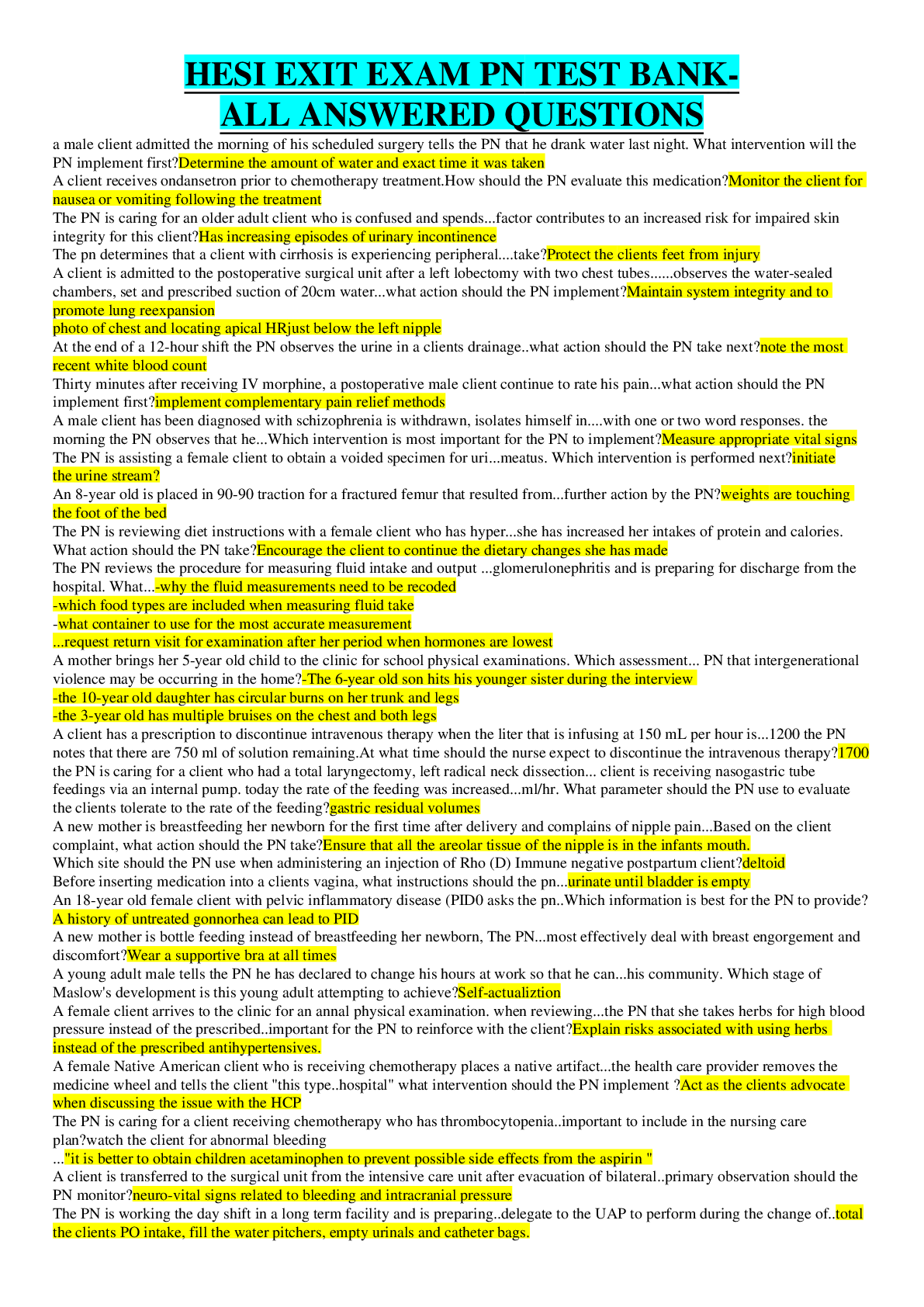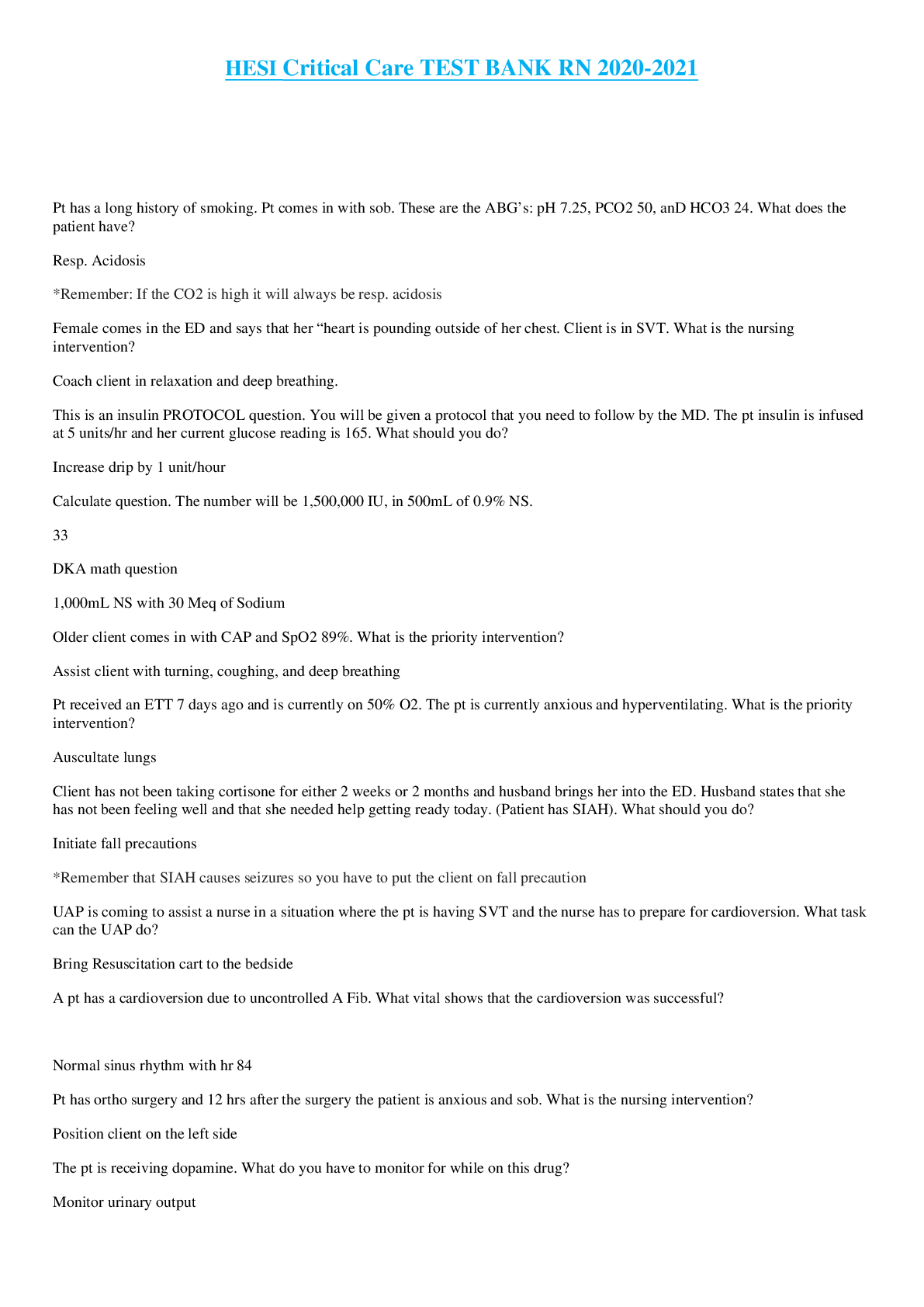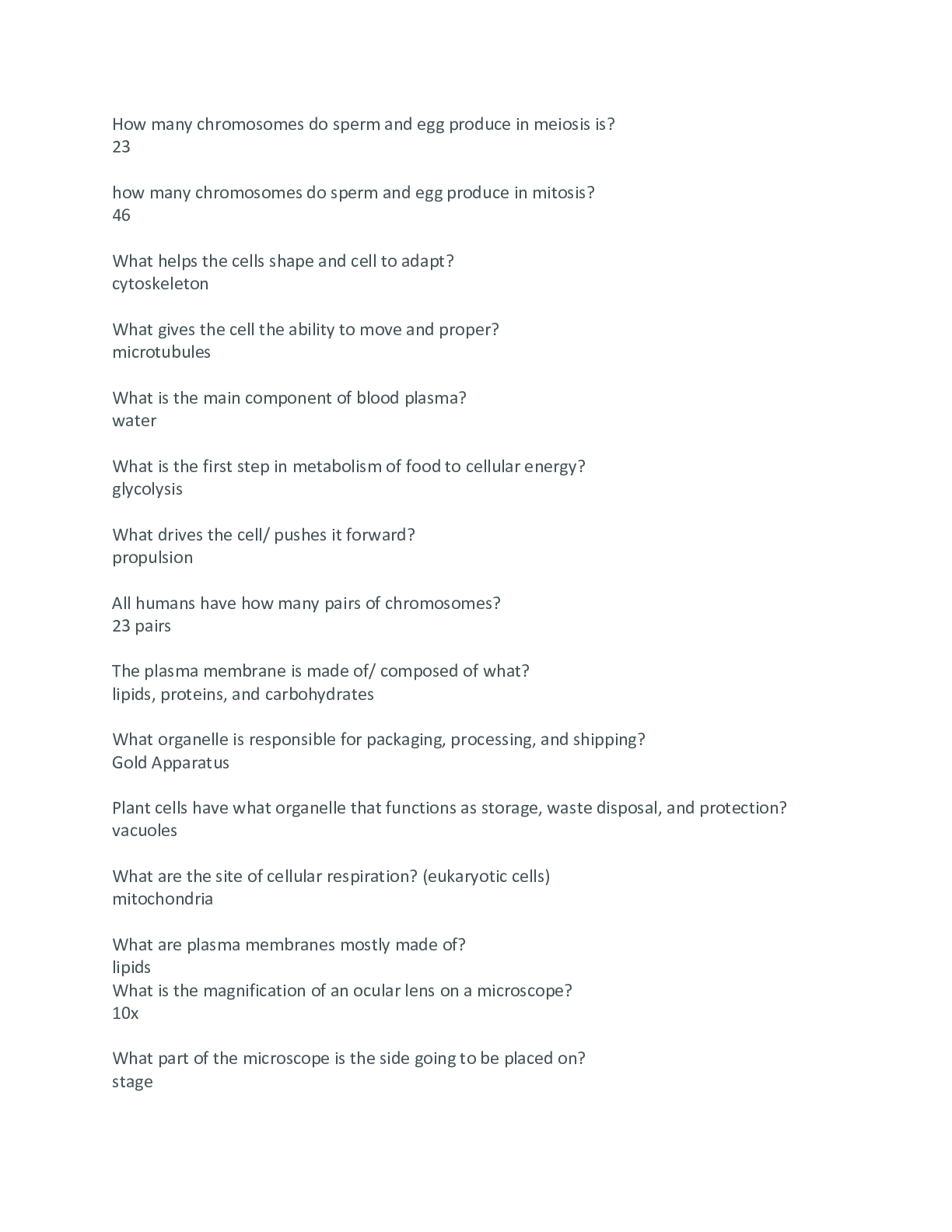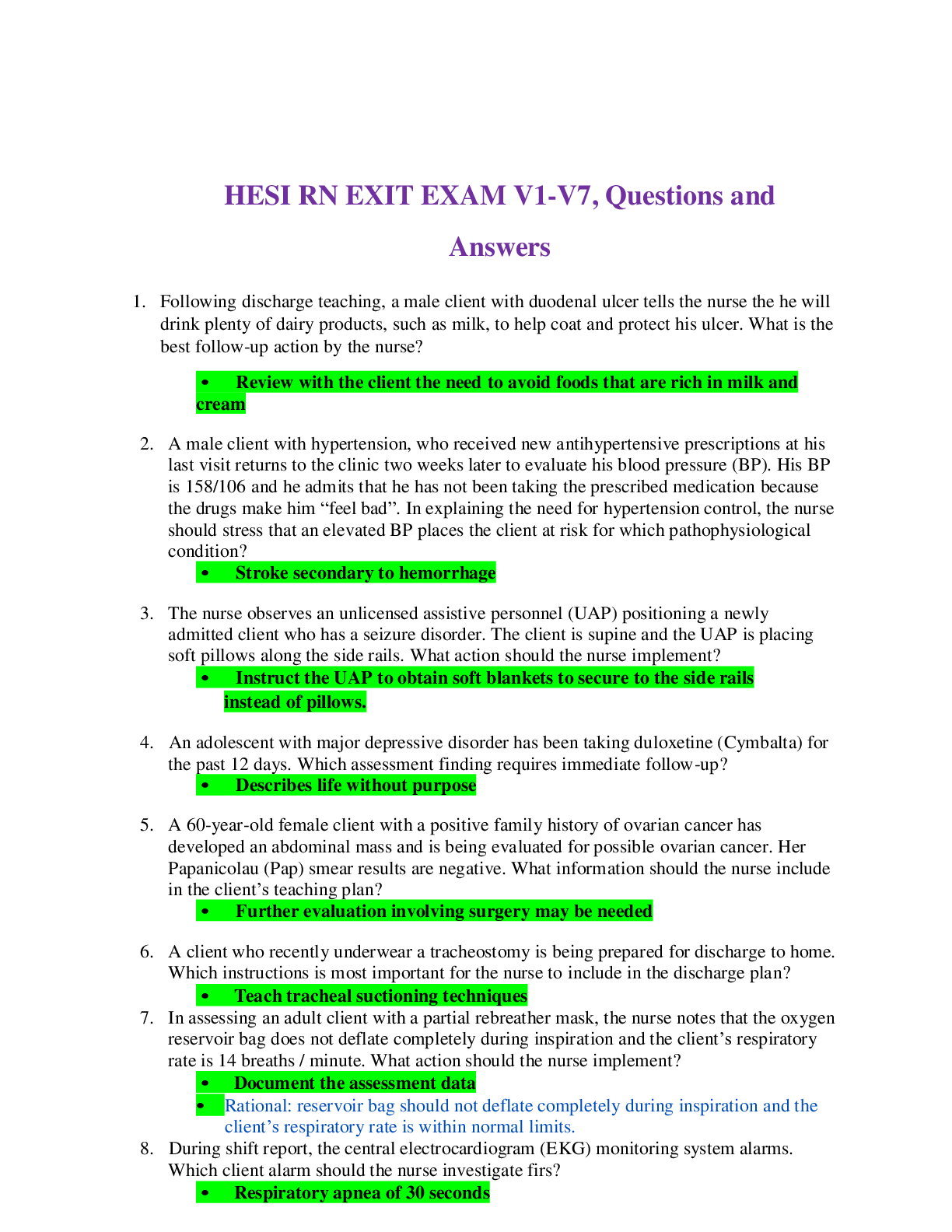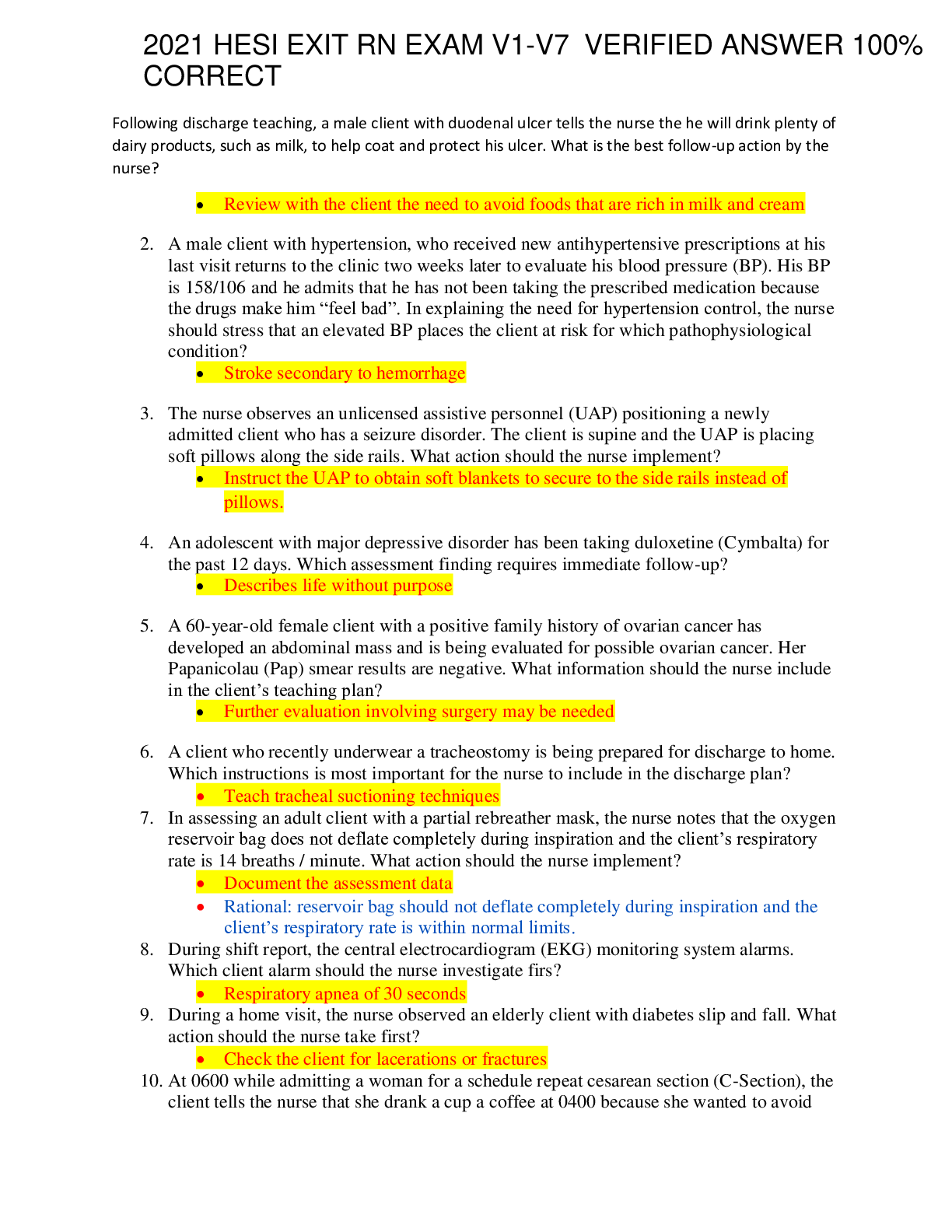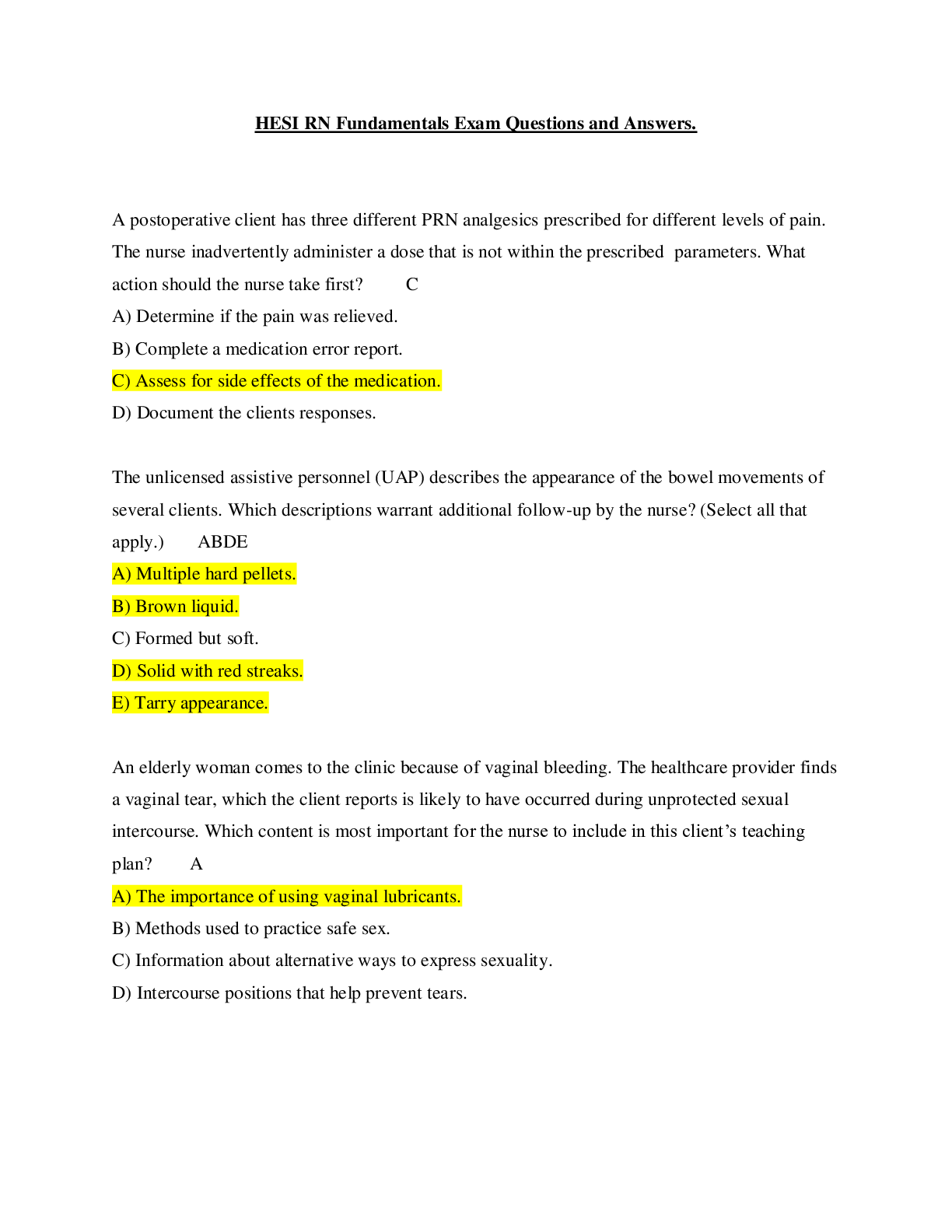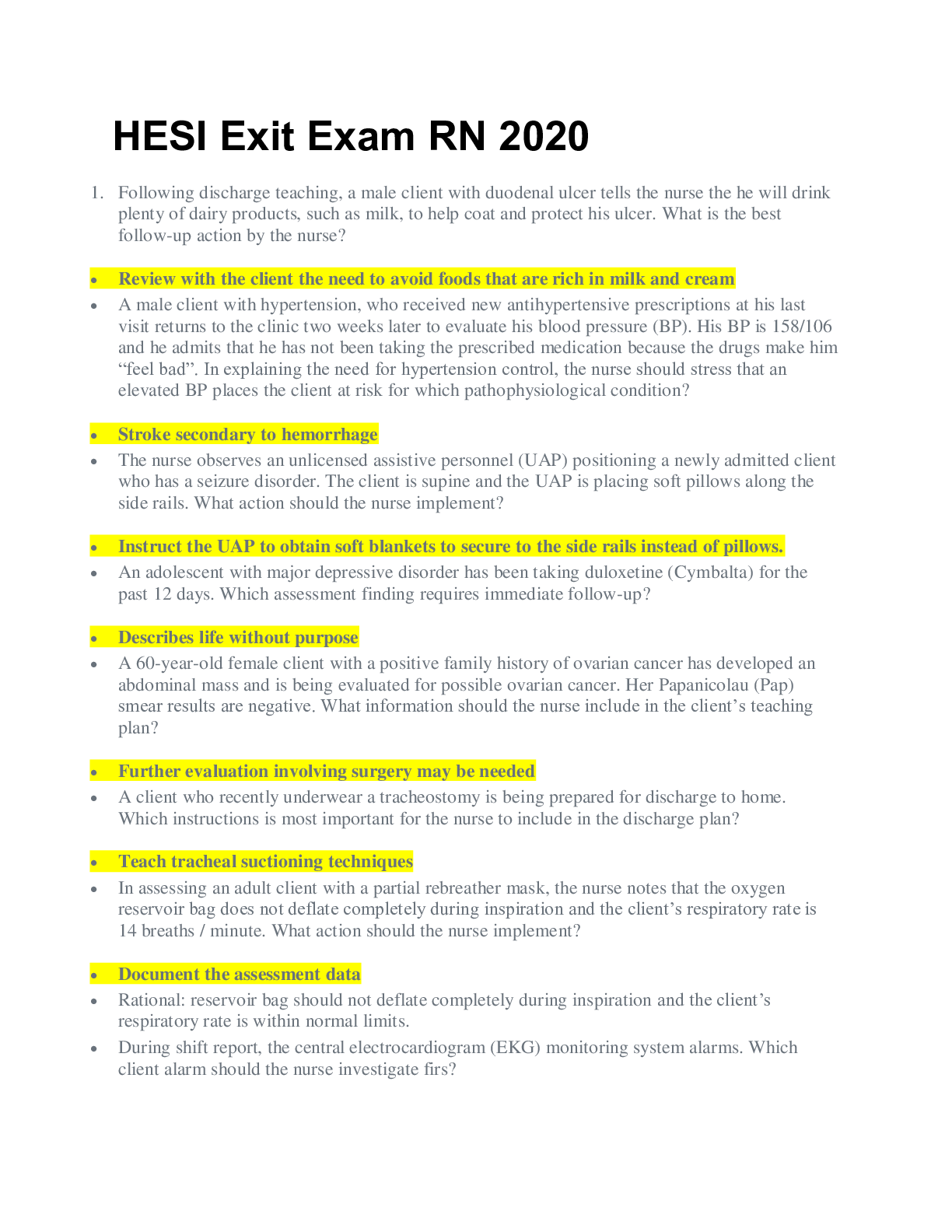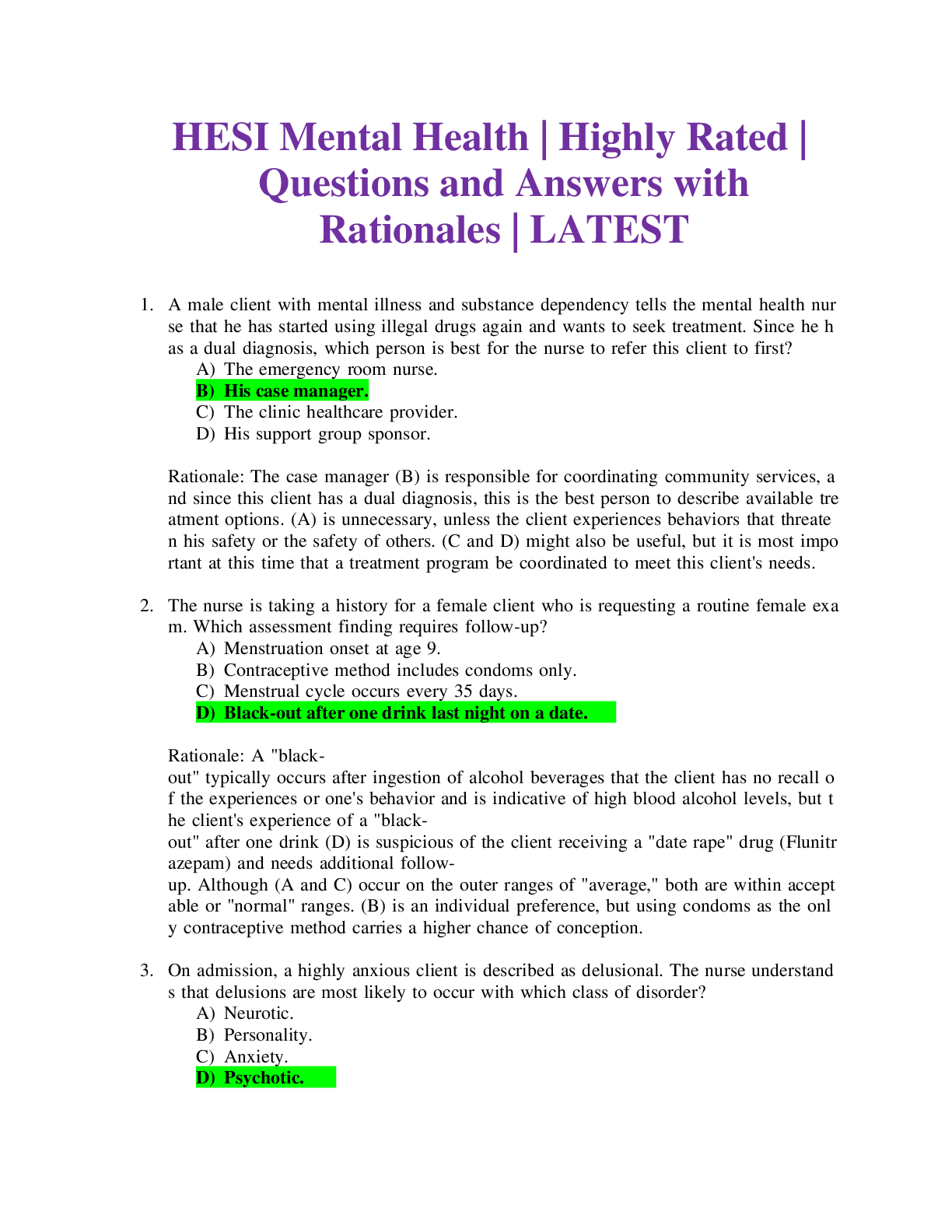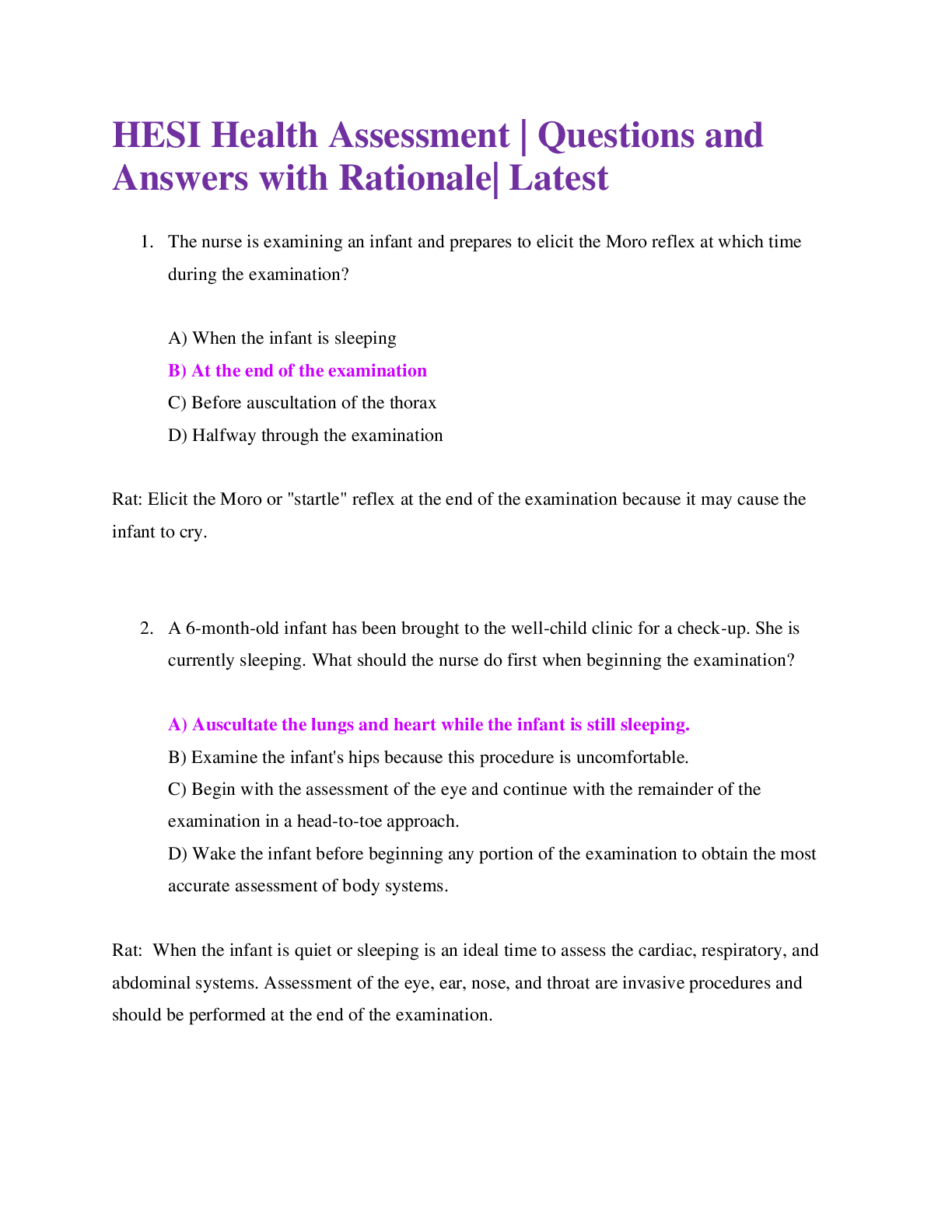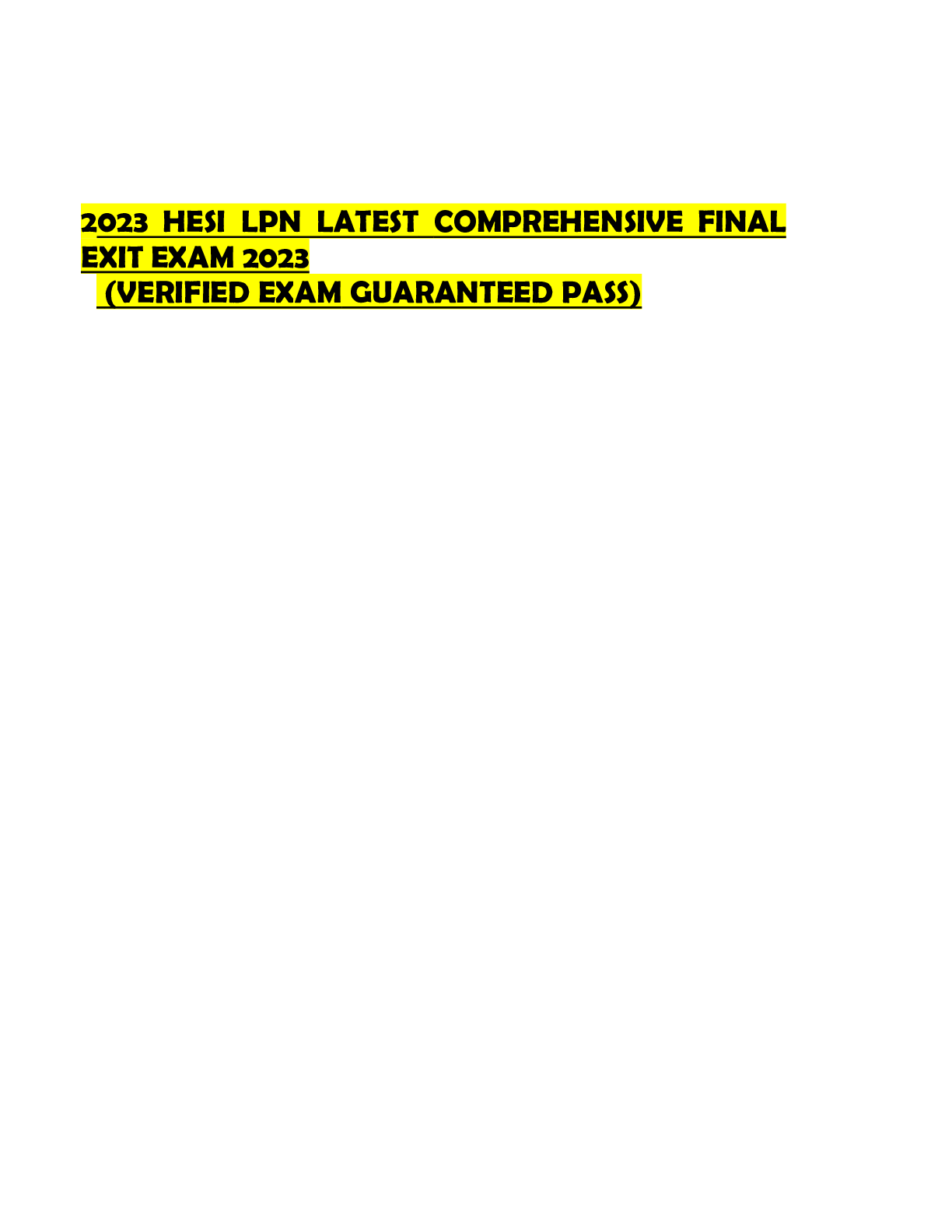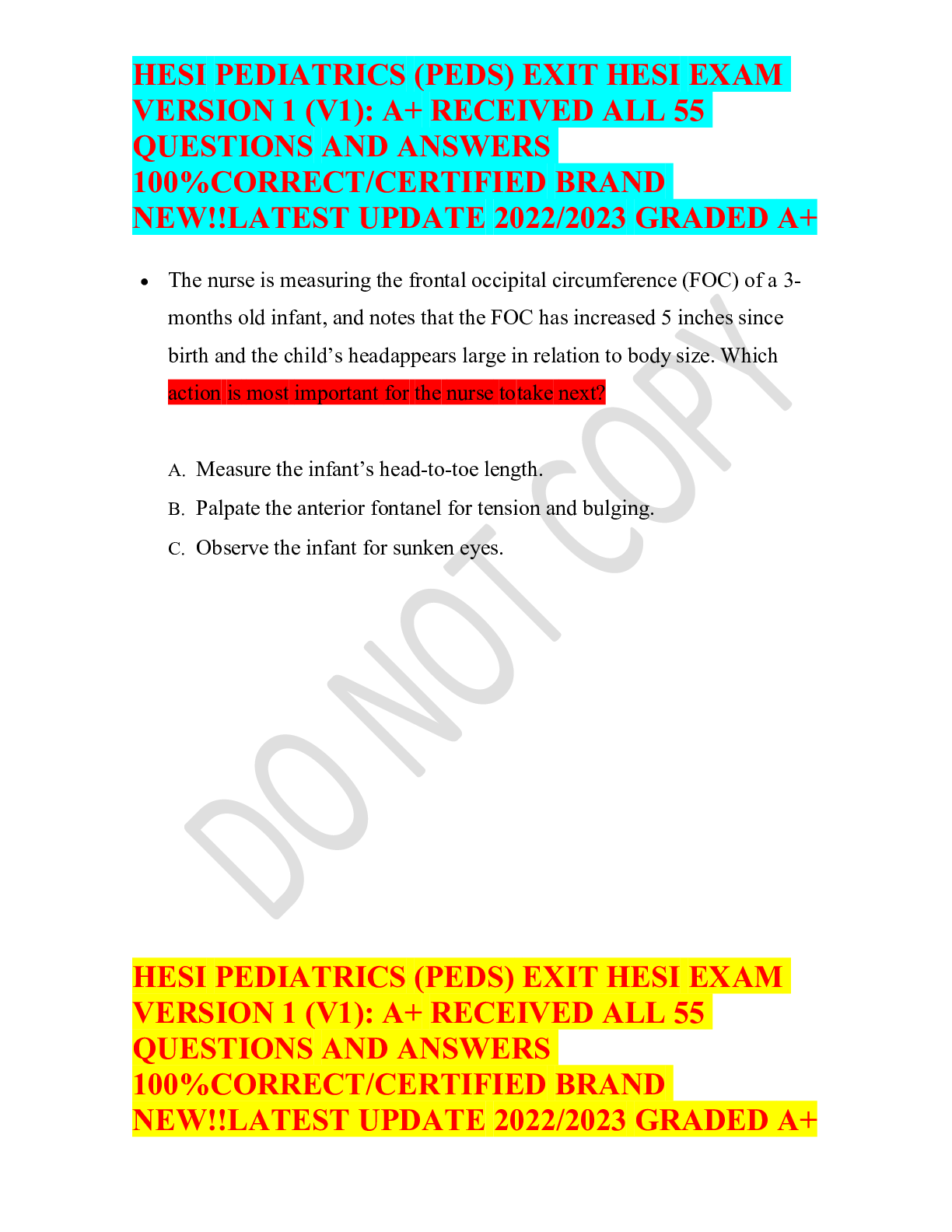2023 pn hesi exit exam(SCORE an A)
Document Content and Description Below
1) The nurse is monitoring a client following cardioversion. Which observations should be of highest priority to the nurse? 1. Blood pressure 2. Status of airway 3. Oxygen flow rate 4. Level... of consciousness Correct Answer: 2. Status of airway 2) The LPN/LVN in a medical unit is caring for a client with heart failure. The client suddenly develops extreme dyspnea, tachycardia, and lung crackles, and the nurse suspects pulmonary edema. The nurse immediately notifies the registered nurse and expects which interventions to be prescribed? Select all that apply. 1. Administering oxygen 2. Inserting a Foley catheter 3. Administering furosemide (Lasix) 4. Administering morphine sulfate intravenously 5. Transporting the client to the coronary care unit 6. Placing the client in a low-Fowler's side-lying position Correct Answer: 1. Administering oxygen 2. Inserting a Foley catheter 3. Administering furosemide (Lasix) 3) The LPN/LVN is preparing to ambulate a postoperative client after cardiac surgery. The nurse plans to do which to enable the client to best tolerate the ambulation? 1. Provide the client with a walker. 2. Remove the telemetry equipment. 3. Encourage the client to cough and deep breathe. 4. Premedicate the client with an analgesic before ambulating. Correct Answer: 4. Premedicate the client with an analgesic before ambulating 4) The nurse is assisting in caring for the client immediately after insertion of a permanent demand pacemaker via the right subclavian vein. The nurse prevents dislodgement of the pacing catheter by implementing which intervention? 1. Limiting movement and abduction of the left arm 2. Limiting movement and abduction of the right arm 3. Assisting the client to get out of bed and ambulate with a walker 4. Having the physical therapist do active range of motion to the right arm Correct Answer: 2. Limiting movement and abduction of the right arm 5) A client is wearing a continuous cardiac monitor, which begins to alarm at the nurse's station. The nurse sees no electrocardiographic complexes on the screen. The nurse should do which first? 1. Call a code blue. 2. Call the health care provider. 3. Check the client status and lead placement. 4. Press the recorder button on the ECG console. Correct Answer: 3. Check the client status and lead placement. 6) A client diagnosed with thrombophlebitis 1 day ago suddenly complains of chest pain and shortness of breath, and the client is visibly anxious. The LPN/LVN understands that a life-threatening complication of this condition is which? 1. Pneumonia 2. Pulmonary edema 3. Pulmonary embolism 4. Myocardial infarction Correct Answer: 3. Pulmonary embolism 7) A 24-year-old man seeks medical attention for complaints of claudication in the arch of the foot. The nurse also notes superficial thrombophlebitis of the lower leg. The nurse should check the client for which next? 1. Smoking history 2. Recent exposure to allergens 3. History of recent insect bites 4. Familial tendency toward peripheral vascular disease Correct Answer: 1. Smoking history 8) The nurse has reinforced instructions to the client with Raynaud's disease about self-management of the disease process. The nurse determines that the client needs further teaching if the client states which? 1. "Smoking cessation is very important." 2. "Moving to a warmer climate should help." 3. "Sources of caffeine should be eliminated from the diet." 4. "Taking nifedipine (Procardia) as prescribed will decrease vessel spasm." Correct Answer: 2. "Moving to a warmer climate should help." 9) A client with myocardial infarction suddenly becomes tachycardic, shows signs of air hunger, and begins coughing frothy, pink-tinged sputum. The nurse listens to breath sounds, expecting to hear which breath sounds bilaterally? 1. Rhonchi 2. Crackles 3. Wheezes 4. Diminished breath sounds Correct Answer: 2. Crackles 10) The LPN/LVN is collecting data on a client with a diagnosis of right- sided heart failure. The nurse should expect to note which specific characteristic of this condition? 1. Dyspnea 2. Hacking cough 3. Dependent edema 4. Crackles on lung auscultation Correct Answer: 3. Dependent edema 11) The LPN/LVN is checking the neurovascular status of a client who returned to the surgical nursing unit 4 hours ago after undergoing an aortoiliac bypass graft. The affected leg is warm, and the nurse notes redness and edema. The pedal pulse is palpable and unchanged from admission. The nurse interprets that the neurovascular status is which? 1. Moderately impaired, and the surgeon should be called 2. Normal, caused by increased blood flow through the leg 3. Slightly deteriorating, and should be monitored for another hour 4. Adequate from an arterial approach, but venous complications are arising Correct Answer: 2. Normal, caused by increased blood flow through the leg 12) A client with a diagnosis of rapid rate atrial fibrillation asks the nurse why the health care provider is going to perform carotid massage. The LPN/LVN responds that this procedure may stimulate which? 1. Vagus nerve to slow the heart rate 2. Vagus nerve to increase the heart rate 3. Diaphragmatic nerve to slow the heart rate 4. Diaphragmatic nerve to increase the heart rate Correct Answer: 1. Vagus nerve to slow the heart rate 13) A client is admitted to the hospital with possible rheumatic endocarditis. The LPN/LVN should check for a history of which type of infection? 1. Viral infection 2. Yeast infection 3. Streptococcal infection 4. Staphylococcal infection Correct Answer: 3. Streptococcal infection 14) A client has an Unna boot applied for treatment of a venous stasis leg ulcer. The LPN/LVN notes that the client's toes are mottled, and cool and the client verbalizes some numbness and tingling of the foot. Which interpretation should the nurse make of these findings? 1. The boot has not yet dried. 2. The boot is controlling leg edema. 3. The boot is impairing venous return. 4. The boot has been applied too tightly. Correct Answer: 4. The boot has been applied too tightly. 15) A client with angina complains that the anginal pain is prolonged and severe and occurs at the same time each day, most often in the morning. On further data collection, the nurse notes that the pain occurs in the absence of precipitating factors. How should the LPN/LVN best describe this type of anginal pain? 1. Stable angina 2. Variant angina 3. Unstable angina 4. Nonanginal pain Correct Answer: 2. Variant angina 16) The LPN/LVN is monitoring a client with an abdominal aortic aneurysm (AAA). Which finding is probably unrelated to the AAA? 1. Pulsatile abdominal mass 2. Hyperactive bowel sounds in the area 3. Systolic bruit over the area of the mass 4. Subjective sensation of "heart beating" in the abdomen Correct answer: 2. Hyperactive bowel sounds in the area 17) An emergency department client who complains of slightly improved but unrelieved chest pain for 2 days is reluctant to take a nitroglycerin sublingual tablet offered by the nurse. The client states, "I don't need that—my dad takes that for his heart. There's nothing wrong with my heart." Which description best describes the client's response? 1. Angry 2. Denial 3. Phobic 4. Obsessive-compulsive Correct Answer: 2. Denial 18) A client is scheduled for a cardiac catheterization using a radiopaque dye. The LPN/LVN checks which most critical item before the procedure? 1. Intake and output 2. Height and weight 3. Peripheral pulse rates 4. Prior reaction to contrast media Correct Answer: 4. Prior reaction to contrast media 19) A client is scheduled for a dipyridamole thallium scan. The LPN/ LVN should check to make sure that the client has not consumed which substance before the procedure? 1. Caffeine 2. Fatty meal 3. Excess sugar 4. Milk products Correct Answer: 1. Caffeine 20) An ambulatory clinic nurse is interviewing a client who is complaining of flulike symptoms. The client suddenly develops chest pain. Which question best assists the nurse to discriminate pain caused by a non cardiac problem? 1. "Can you describe the pain to me?" 2. "Have you ever had this pain before?" 3. "Does the pain get worse when you breathe in?" 4. "Can you rate the pain on a scale of 1 to 10, with 10 being the worst?" Correct Answer: 3. "Does the pain get worse when you breathe in?" [Show More]
Last updated: 9 months ago
Preview 1 out of 54 pages
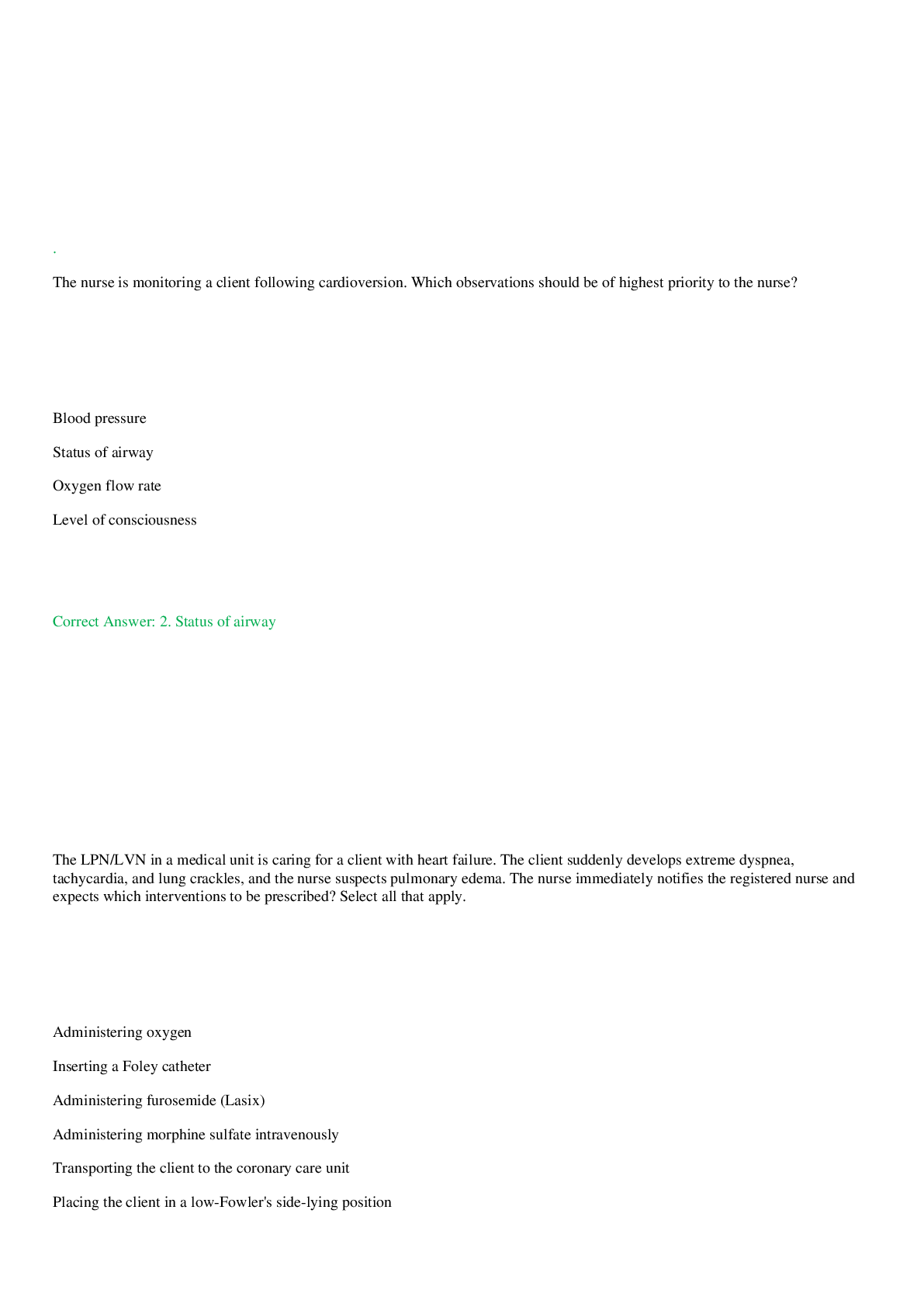
Reviews( 0 )
Document information
Connected school, study & course
About the document
Uploaded On
Jul 12, 2023
Number of pages
54
Written in
Additional information
This document has been written for:
Uploaded
Jul 12, 2023
Downloads
0
Views
118

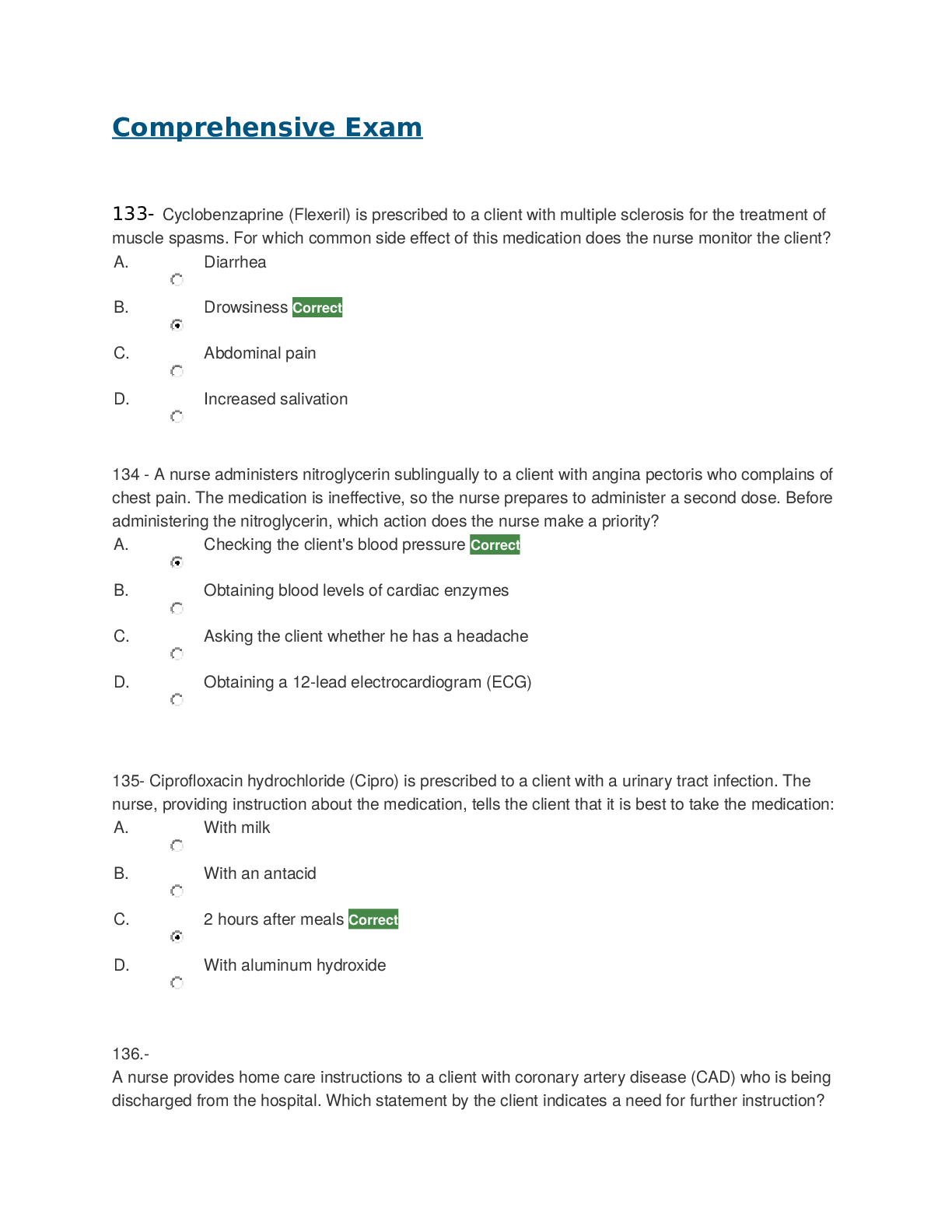
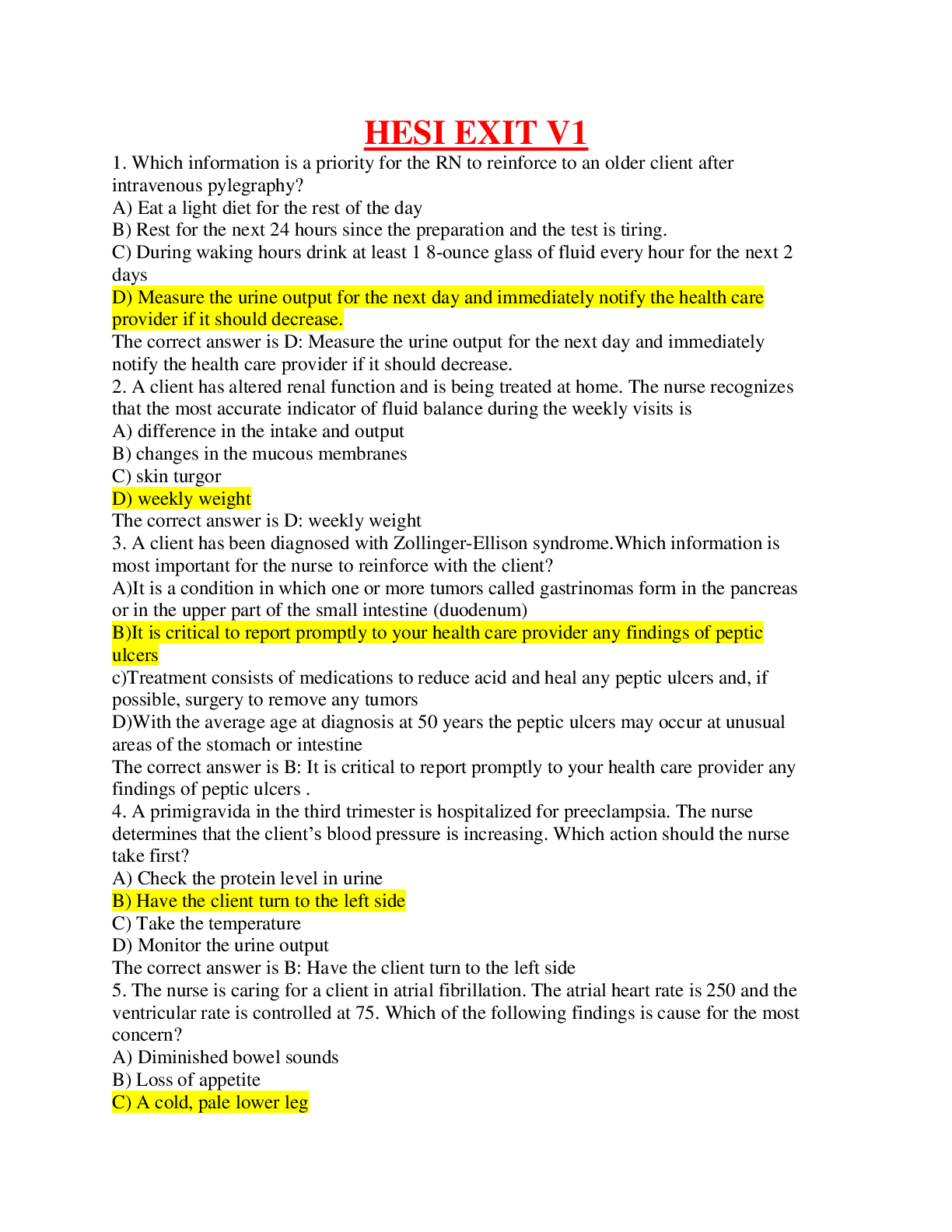
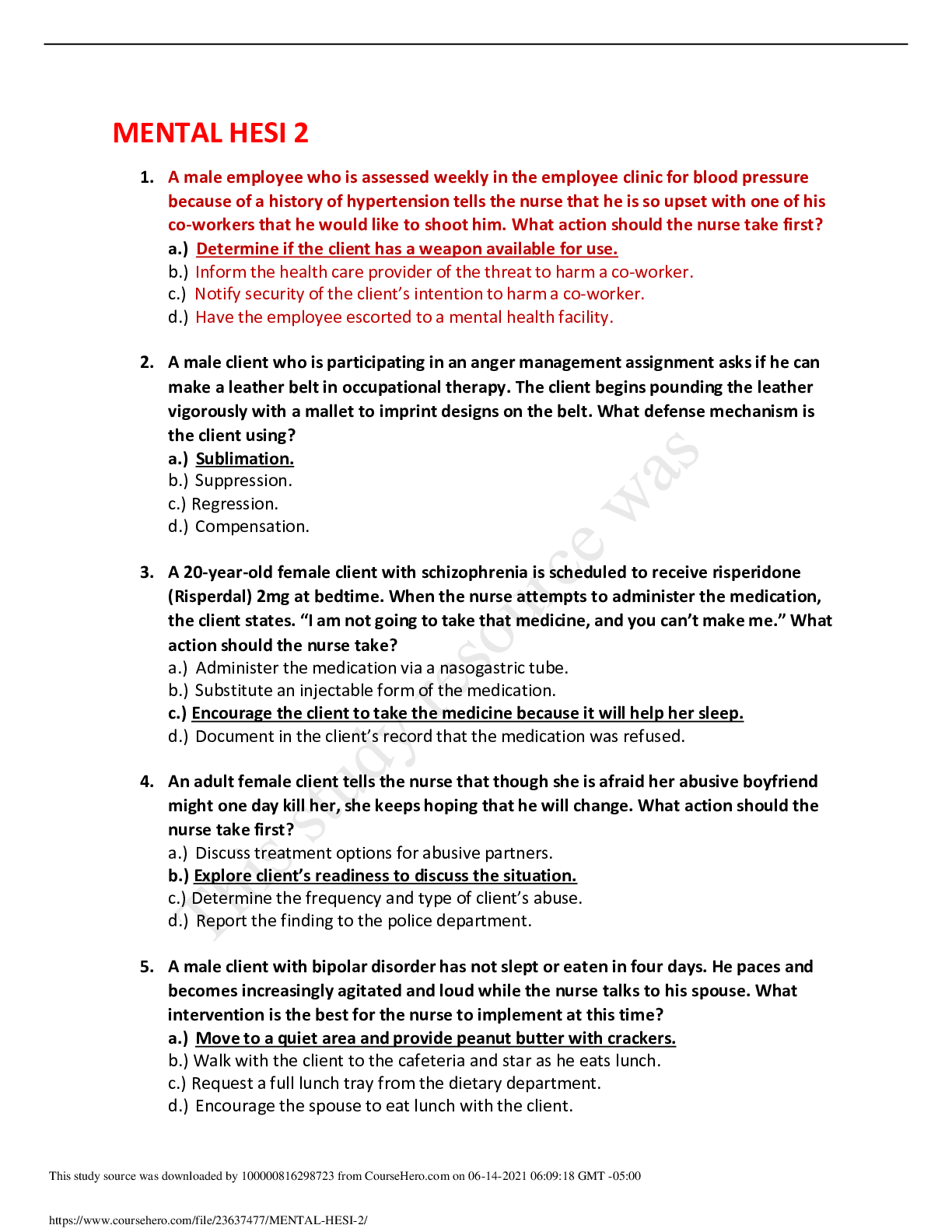
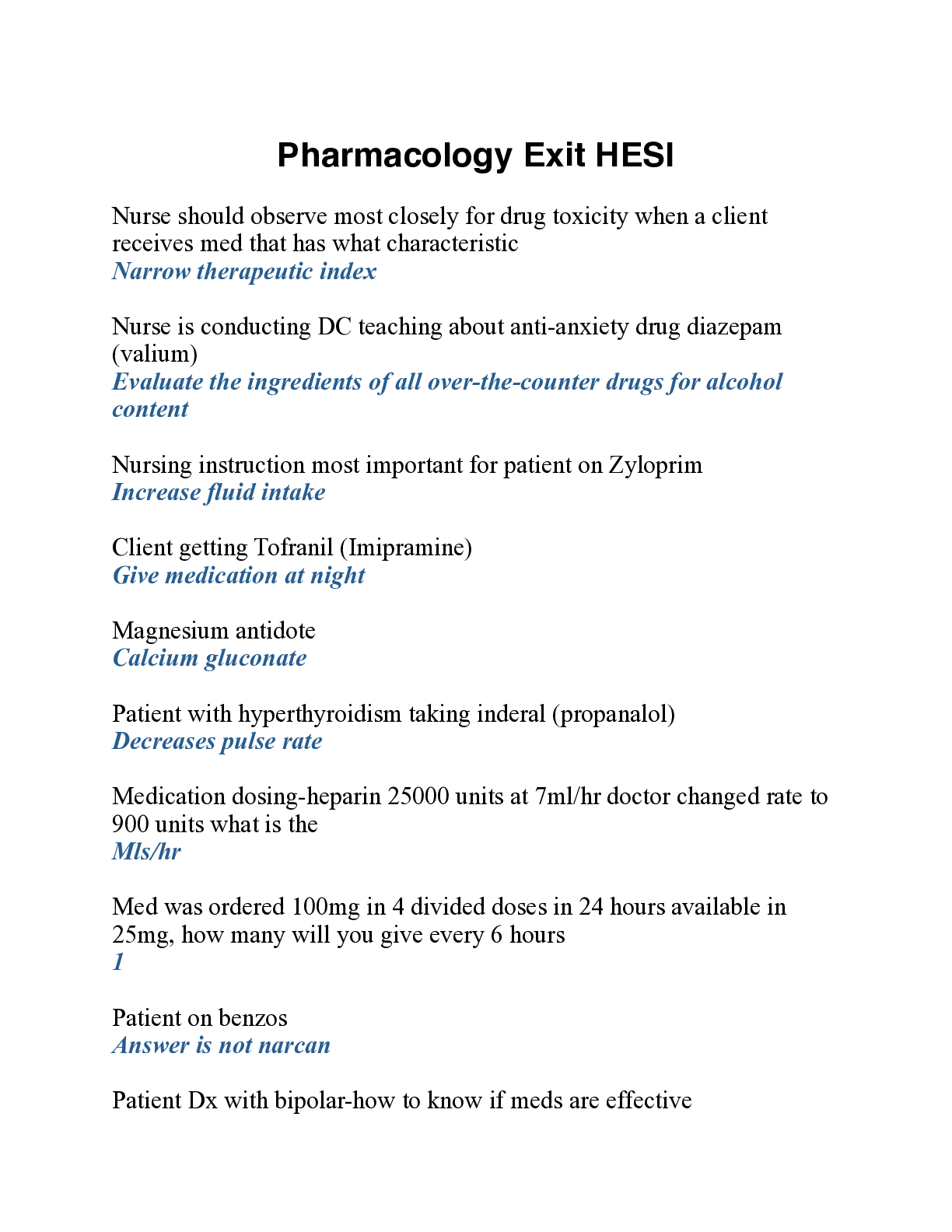
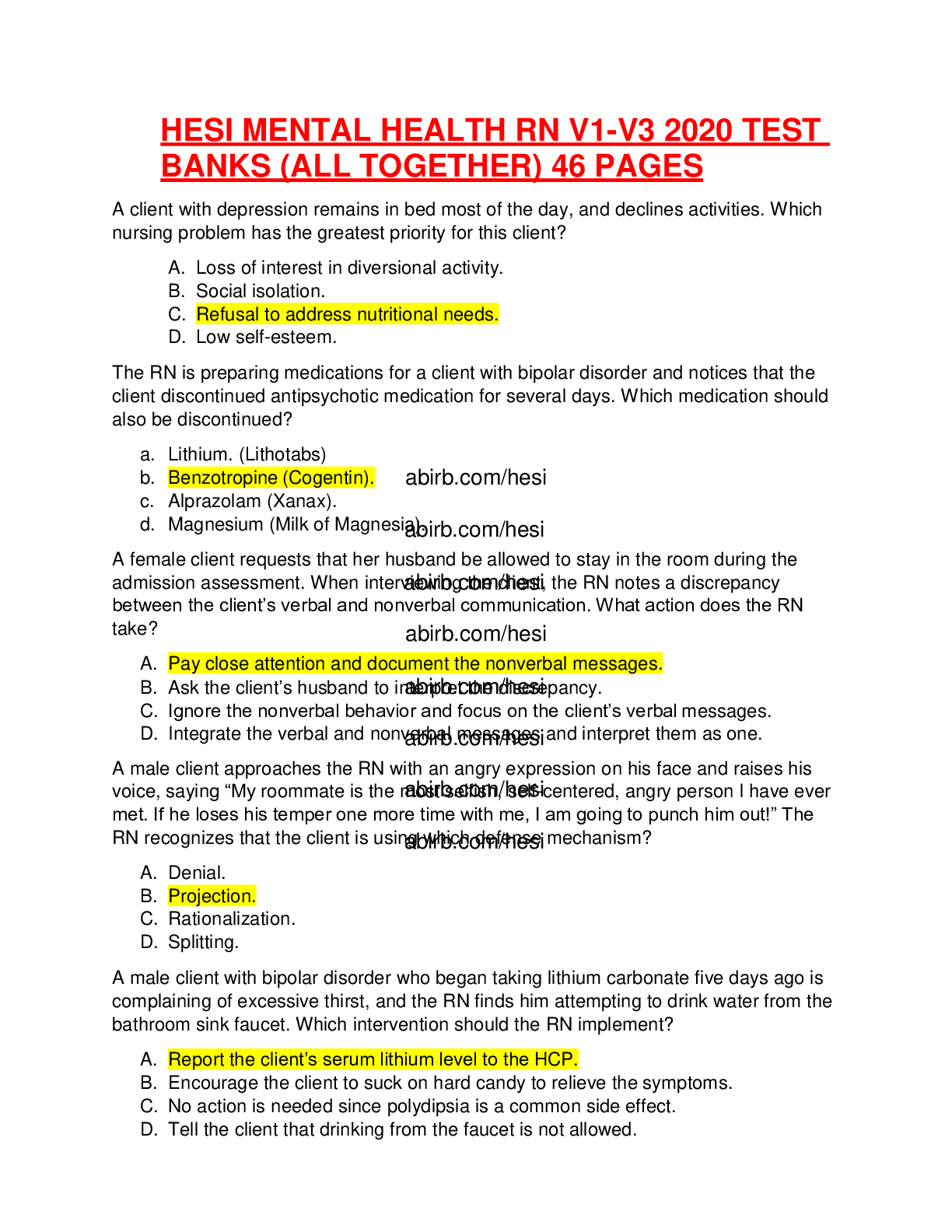

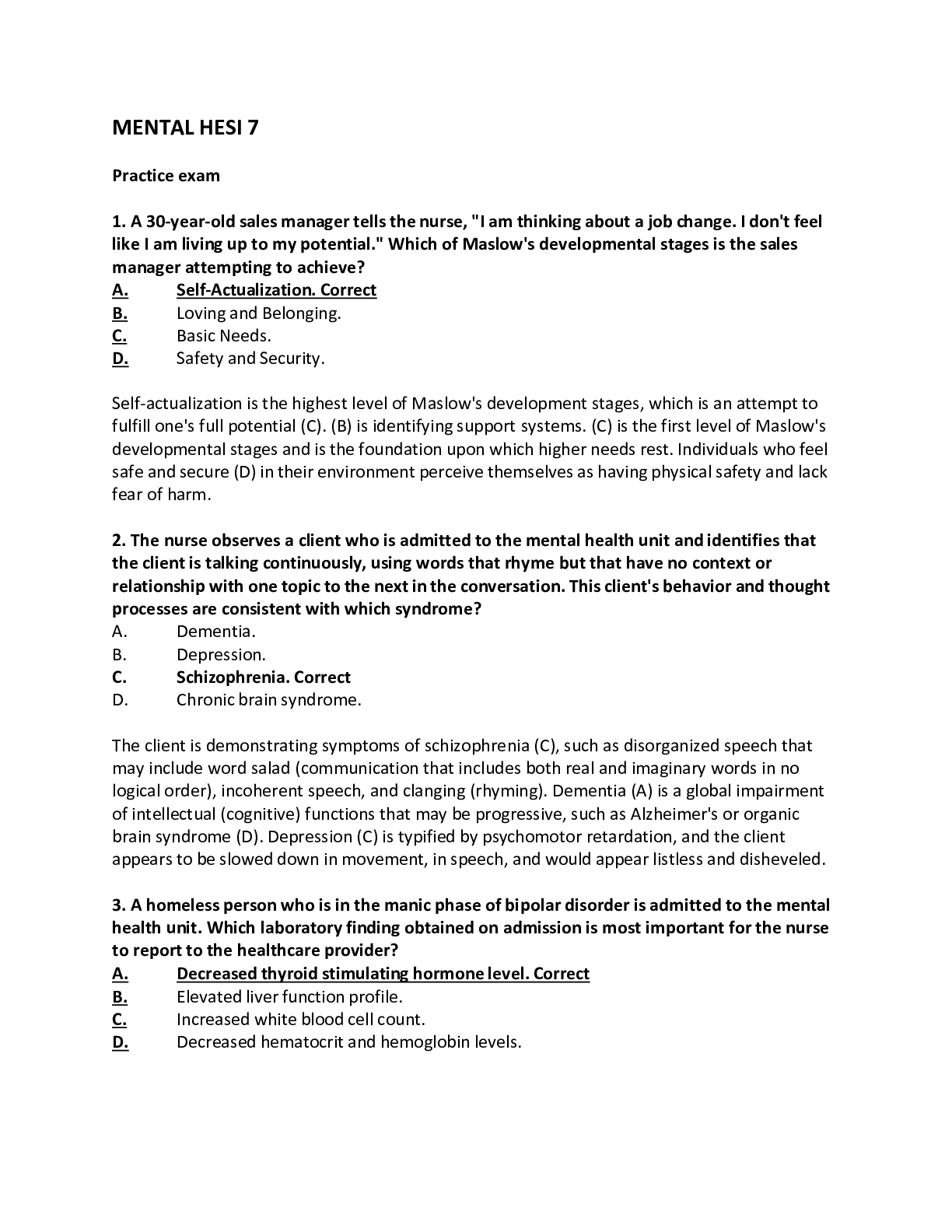
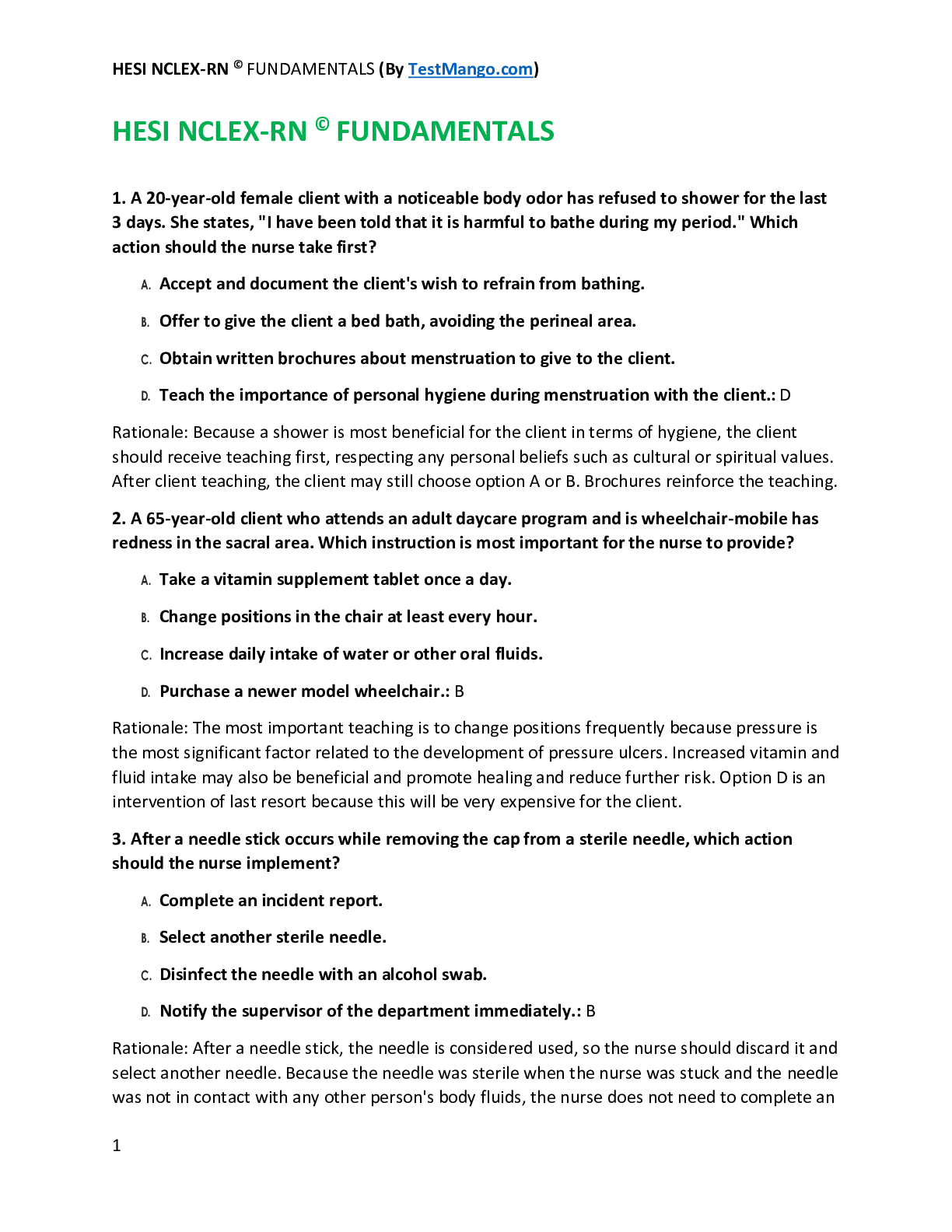
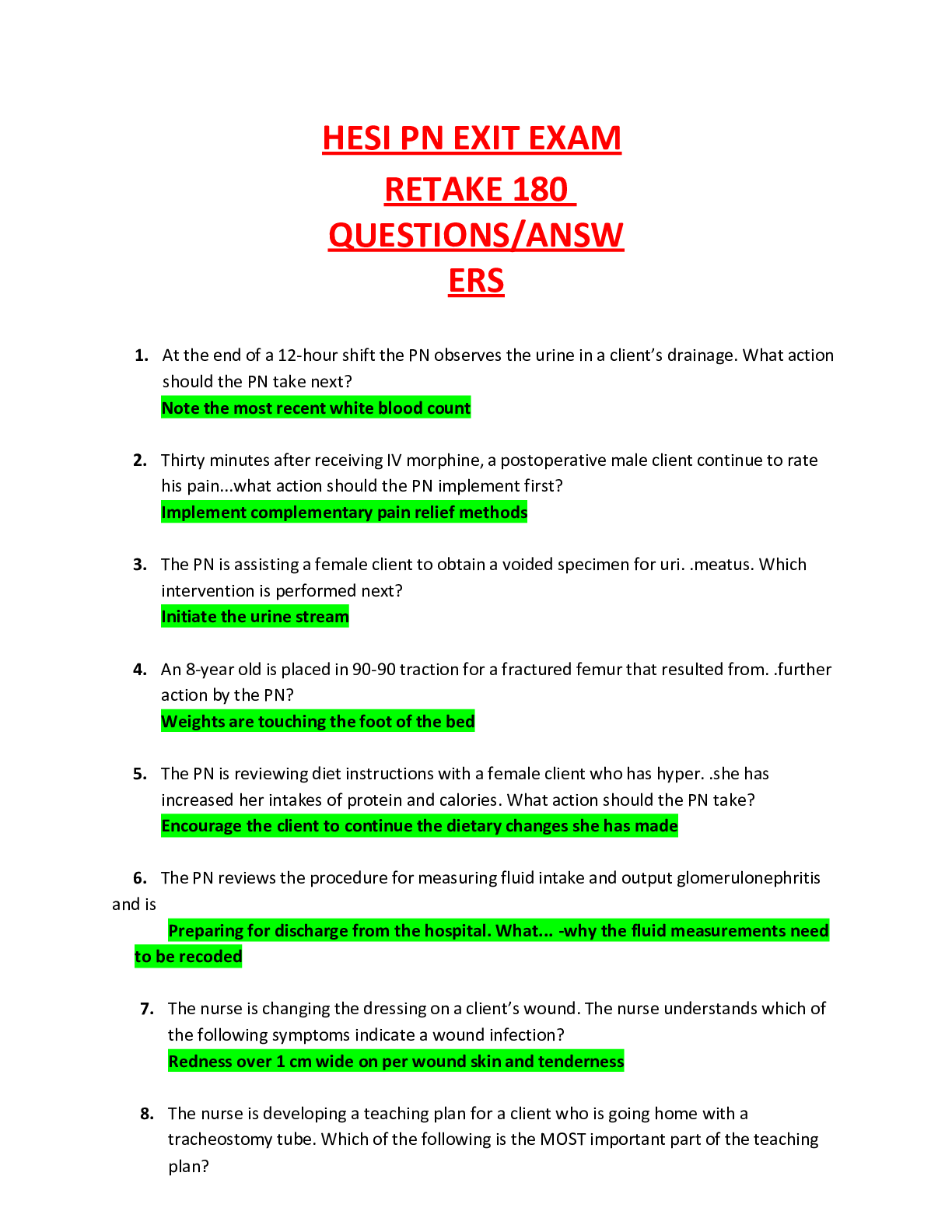


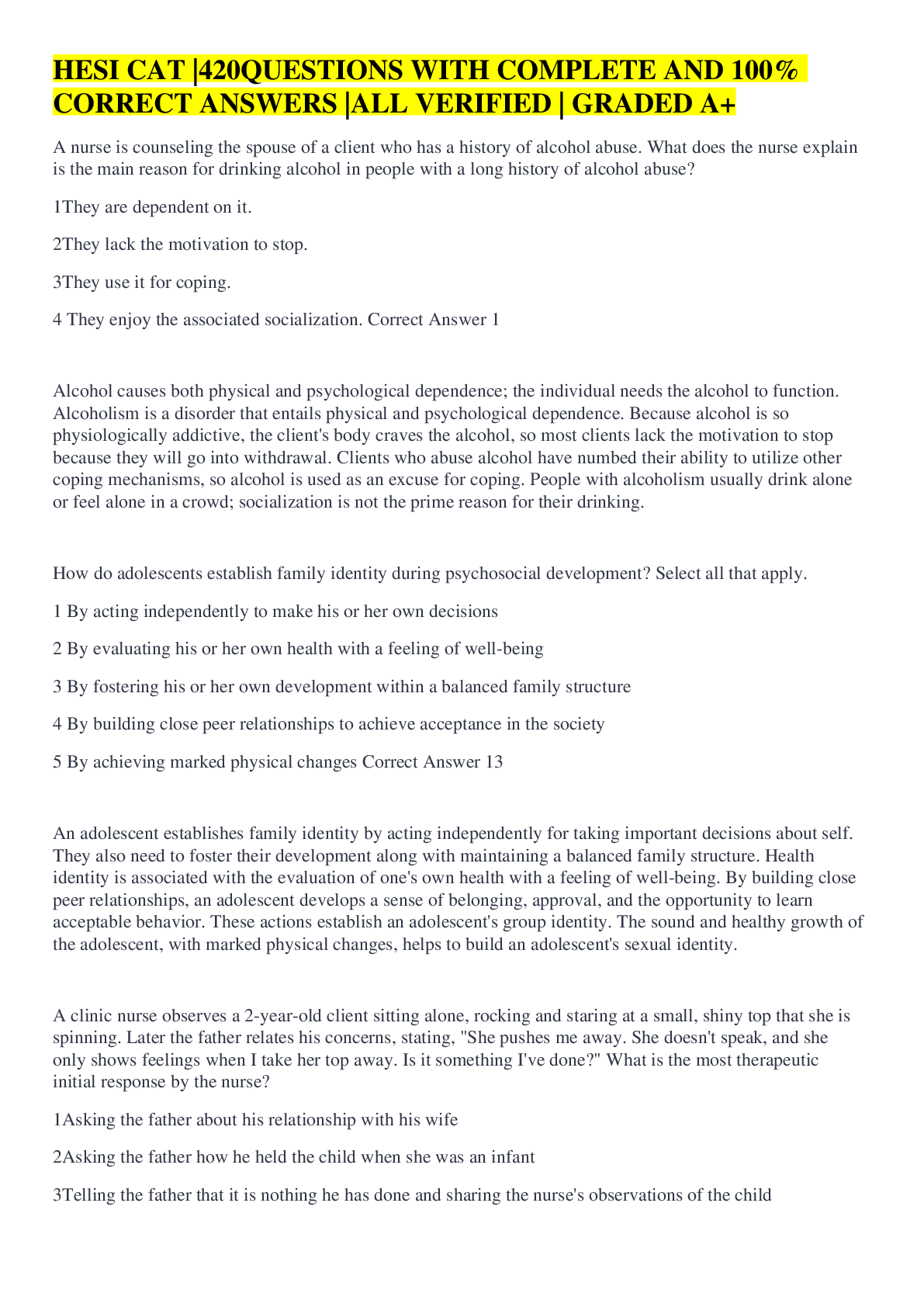
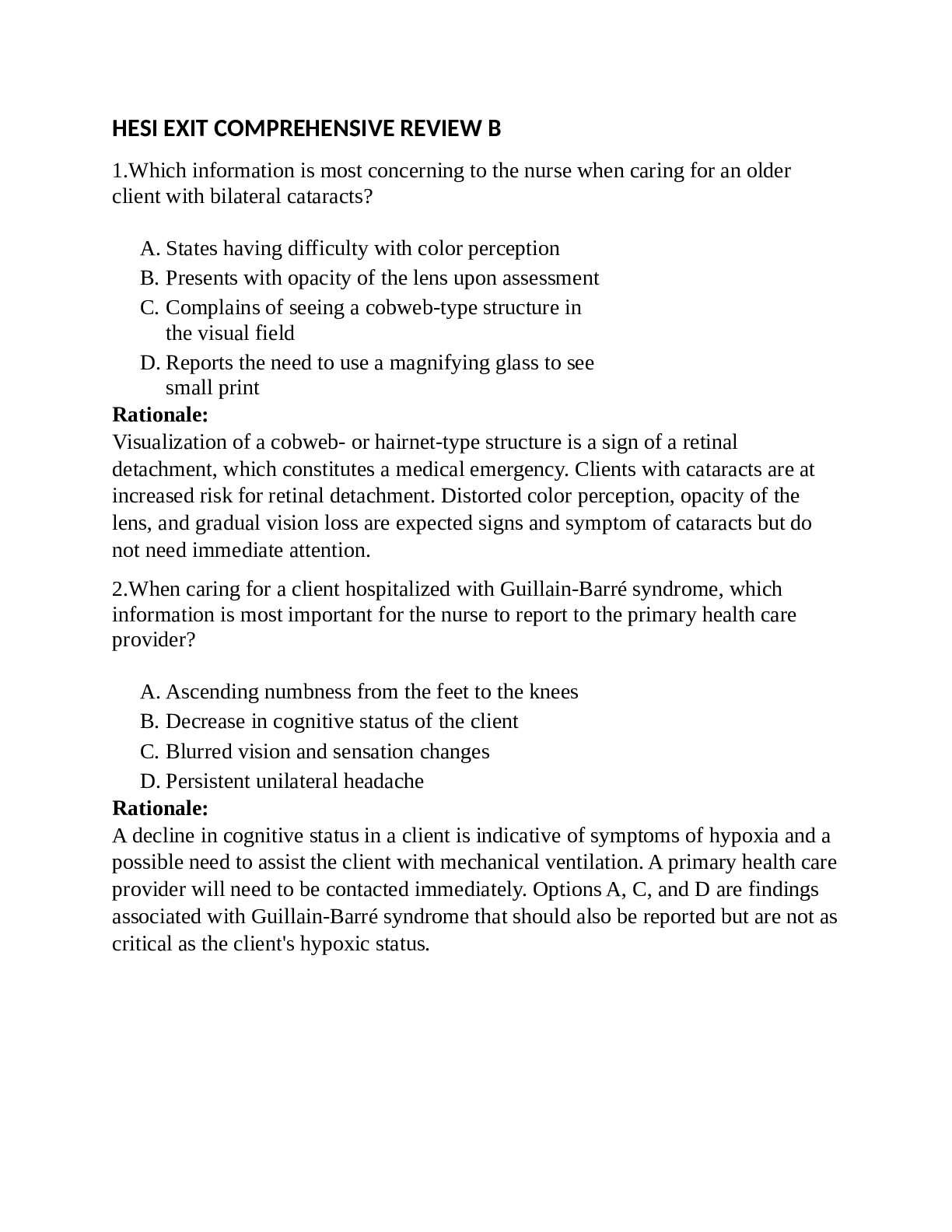
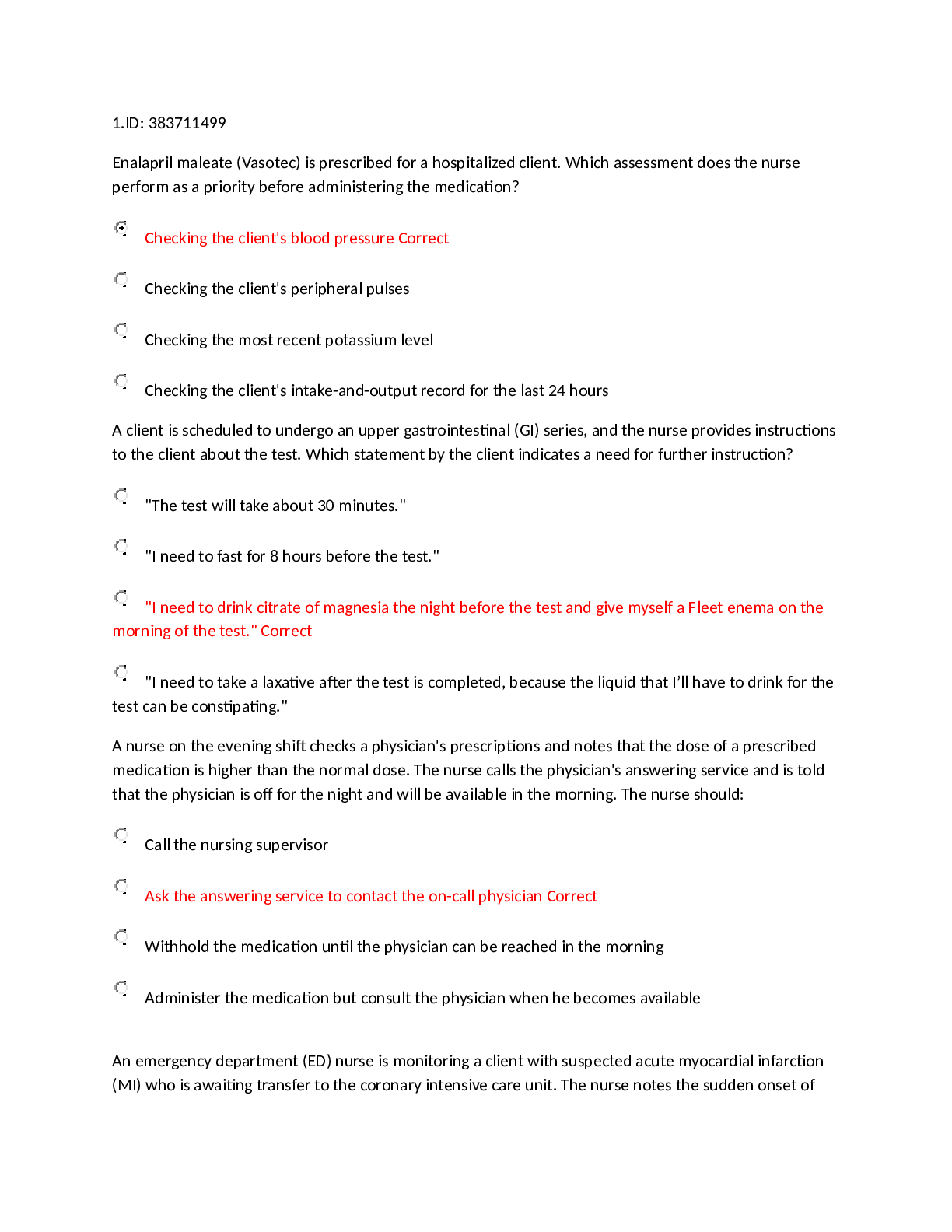



 (1).png)



